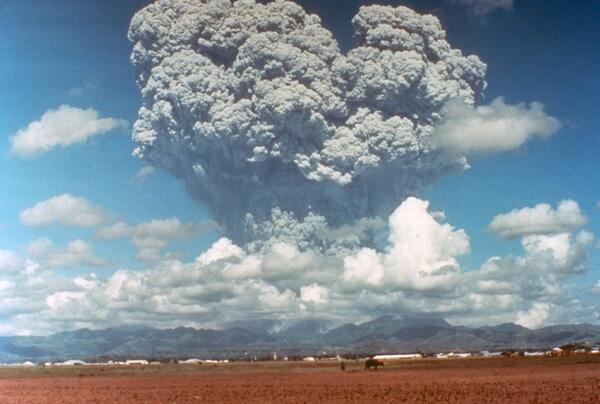USGS-USAID Volcano Disaster Assistance Program honored with American Geophysical Union 2024 International Award
Award Winning U.S. Geological Survey Partnership
For its outstanding contribution to furthering Earth science and using science for the benefit of society in developing nations, USGS-USAID Volcano Disaster Assistance Program has been named recipient of the American Geophysical Union’s 2024 International Award.
Volcano Disaster Assistance Program has had a deep and lasting impact on the global community. Since 1986, team members have responded to over 70 major volcanic crises at more than 50 volcanoes and have strengthened response capacity in 22 countries. The Volcano Disaster Assistance Program trains volcano observatory scientists, assists in volcano crisis response, provides equipment to improve monitoring and interpretive capacity, fosters global dialogue on volcanic hazards, and compassionately supports colleagues facing immensely challenging volcano hazard situations.
A Collaborative Approach to Disaster Preparedness
The Volcano Disaster Assistance Program operates through an interagency agreement between the USAID Bureau for Humanitarian Assistance and the U.S. Geological Survey. The agreement allows the USGS to fund a multidisciplinary team of 24 experts in geophysics, geology, engineering, geochemistry and computer science. The approach enables Volcano Disaster Assistance Program to create comprehensive strategies for volcanic monitoring and risk mitigation tailored to regional needs. In effect, the Volcano Disaster Assistance Program allows the USGS to directly contribute to USAID’s mission to save lives, minimize suffering, and increase the long-term ability of countries to manage their exposure to natural hazards.
Responding to Eruptions and Volcanic Unrest
“The Volcano Disaster Assistance Program, or VDAP, plays a crucial role in mitigating the impacts of volcanic eruptions and unrest around the world,” said Jake Lowenstern, USGS scientist and Director of VDAP for the past 7 years.
In 1991, VDAP assisted the volcanologists of Philippine Institute of Volcanology and Seismology to forecast events leading up to the cataclysmic June 15 eruption. Their efforts saved an estimated 5,000 to 20,000 lives while also safeguarding at least \$250 million of military equipment from the nearby U.S. Clark Air Force Base. In 2008, VDAP’s timely forecasts and education programs enabled the swift evacuation of 12,000 residents from Belalcázar, Colombia, ahead of a series of volcanic mudflows or lahars, minimizing casualties. During the massive Merapi Volcano eruption in 2010, VDAP’s access to satellite imagery and expertise assisted Indonesian scientists in anticipating pyroclastic flows, which allowed for the efficient evacuation of communities in the danger zone, again saving thousands of lives. Over the past five years, VDAP has provided assistance at damaging eruptions in Ecuador, Indonesia, Papua New Guinea, Philippines, St. Vincent, and several others.
These examples highlight VDAP’s vital contributions to volcano disaster response. The VDAP team works alongside volcano observatories before, during, and after volcanic events, to save lives, minimize destruction through early warning systems and international collaboration, and enhance community resilience in the face of natural disasters.
Providing Monitoring and Forecasting Equipment
While the latest monitoring technology can be crucial in crisis mitigation, countries may lack the resources to educate and train scientists in the highly specialized tasks related to volcano monitoring and interpretation. VDAP supports mission-critical work with donations of time and equipment. For use in the field, VDAP engineers assemble robust instruments that are simple to install, easy to maintain, and last for many years. Seismic and Global Positioning System stations are positioned to detect and locate subtle earthquakes and ground movements that may signal an awakening volcano; they are designed to run on solar energy and relay their data in real time through low-power radios. Field engineers from partner agencies learn how to install and maintain the systems either at home on their volcanoes, or during a visit to USGS offices in Vancouver, Washington. With experience, they can independently install their own stations and assist neighboring countries, enhancing VDAPs secondary goal of science diplomacy.
VDAP distributes technology to quantify the amounts and types of gas emitted from volcanoes; key indicators used to forecast volcano behavior. In the past, volcano scientists had to make measurements in unsafe locations or fly through the volcanic plume in small aircraft to make measurements. Today, VDAP scientists and engineers deploy scanning ultraviolet spectrometers to measure the volcanic output of sulfur dioxide, a key indicator of underground magma. They also designed robust gas "sniffers" (called Multi-GAS) to determine the ratio of sulfur dioxide to other key gases such as carbon dioxide, which can hint at magma depth and the pathways by which gas reaches the surface. Both technologies can send data directly to the volcano observatory, without the need for frequent servicing of the instruments.
American Geophysical Union International Award
The American Geophysical Union honored VDAP and its multidisciplinary group of scientists and technicians with the 2024 International Award. The award recognized their work to support volcano observatories and their stakeholders in resource-limited countries around the world in seismology, geochemistry, hazard mapping, remote sensing, geodesy, computer science, data archiving and any other topics that can assist with achieving best practices and improved risk mitigation as relates to volcanic hazards.
The VDAP team includes Jacob B. Lowenstern, Maurizio Battaglia, Angie Diefenbach, Julie Griswold, Chris Harpel, Zac Hastings, Chris Hight, Peter Kelly, Christoph Kern, Martin LaFevers, Allan Lerner, Chris Lockett, Wendy McCausland, JoAnna Marlow, Sarah Ogburn, Jeremy Pesicek, Stephanie Prejean, Dave Ramsey, Jenny Riker, Aaron Rinehart, Sally Sennert, Jay Wellik, Rick Wessels, and Heather Wright.





